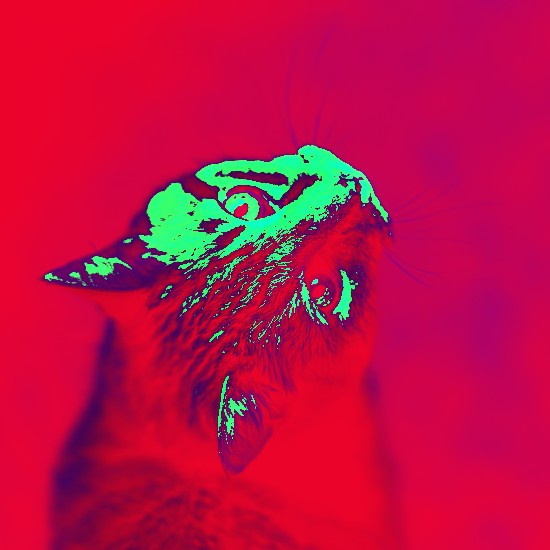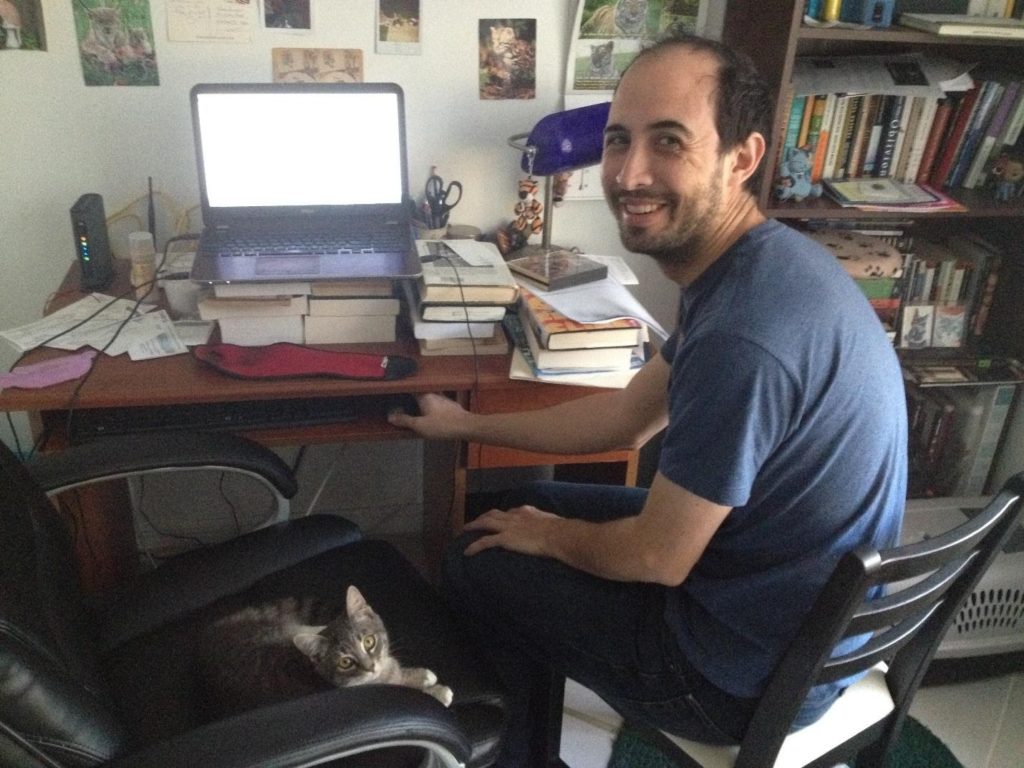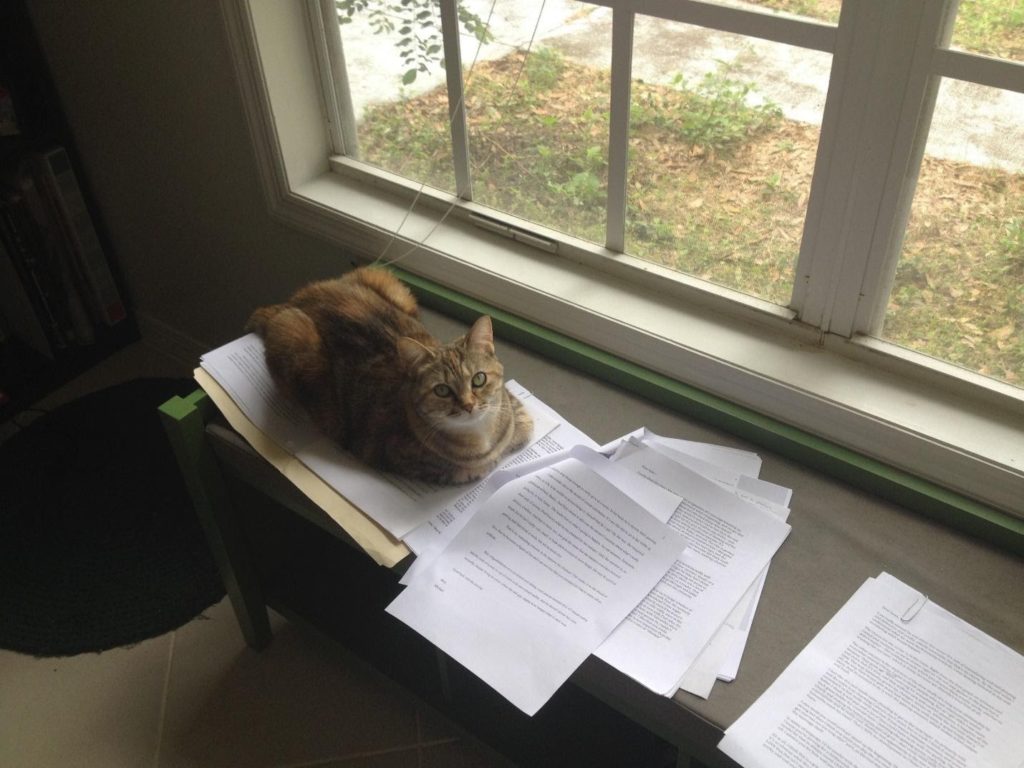
Why You Should Write With a Cat
by Sean Gandert
While technically it’s still possible to write fiction without cats around, I wouldn’t recommend it. Oh I’m certainly familiar with the old saws about writing, that all we need is a room of our own, or perhaps a computer in a coffee shop, or just a notepad and a little bit of follow-through. I’ve certainly done plenty of writing in hotel rooms and while crashing at friends’ houses, on planes and trains and wherever the hell else I happen to be when inspiration (or, more likely, a deadline) has rapped at my head. But none of these methods can compare to writing with cats, and if anyone asks me what my process is, where I draw inspiration from, or how I maintain the discipline to keep working through miserable drafts and numerous rejections, my answer is simple: write with a cat nearby.

Now, anyone who knows me at all well won’t be too surprised by this advice, as I do tend to offer similar words of wisdom regardless of the situation (Had a bad day? Play with a cat. Just got dumped? I bet a cat will cheer you up. The president is a monster causing untold harm to millions out of sheer spite and stupidity? Well sometimes life just sucks like that, but I’m almost certain that rubbing a cat’s belly until they purr with delight would take your mind off our broken political system, if only for a few minutes). And well yes, I am indeed biased towards these fluffy critters, but my argument isn’t based simply on my feline predilection, it’s routed in the way the way they alter your behavior.
Writing is as much about not-writing as it is about, well, writing. I fully realize that sounds insane, so allow me to explain. Actually sitting down at the keyboard and plunking words onto the screen is important, for sure, but it tends to be a single-minded and linear pursuit. Especially for novelists or other writers working with long-form projects, structure is key, and as a result we often move relentlessly forward, trying to keep up with the pace of our outlines in a way that proves a disservice to the work itself. But cats can help prevent this. Cats know no boundaries, either temporal or spatial, and thus are not particularly concerned with your ideas about deadlines or who should or should not be allowed to sit on the keyboard for their mid-afternoon bath. This, despite our immediate frustration, is in fact a good thing, as it causes us to stop and take a break.
I’ve long found those online apps that force you to write so many words within a period of time absolutely insane, as the one thing we don’t need to do is speed up our writing, racing through drafts without a second thought. There’s an infinite amount of fast, sloppy writing in the world, more new Twitter posts every second than can be counted. Cats are the enemy of work focused on quantity, of banging out empty words without another glance, and with this prove the allies of quality, of pauses, of work that fights against the pace of our OCD digital world.
This is not to say that trance states are unimportant, especially for first drafts, but they’re also a hindrance to asking important questions, like whether a character would really do something, or if that dialogue is something a person would indeed say on the bus or if it’s something that just sounds good in our head while we sprint toward the next plot beat. When one of my cats walks beneath my chair, rubs against me, and begs for food, I have to stop my currently runaway train of thought in order to feed them. Sitting back down at my desk, I’m forced to reconsider what it is I’m actually doing, if this is the best way of expressing a character, idea, or phrase. In this manner cats provoke a mindfulness about writing that leads to better work.
This is not to claim that non-stop interruptions are anything but a non-stop hindrance, but that’s not really how cats operate. Instead, they will pop up for a few minutes, then decide you’re being boring in choosing to sit in front of the type-y television screen rather than playing with them. Soon enough they wander away to go bop their sibling on the nose and you’re left on your own, a small break forced upon you but no more. This enables a certain level of conscientiousness without leading to frustration.

This is related to another facet of writing with cats: cats are agents of chaos. They are tricksters. They are clowns and entertainers and completely unpredictable. There is a certain same-yness to writing that can be depressing/exhausting regardless of what you’re working on. Office fatigue is true for many jobs, and while it’s easy to think of writing in the way it’s displayed in movies, as some sort of divinely inspired fervor, that’s not how anyone actually works. Really, there tends to be a lot of drudgery involved, especially when you’ve lost number of how many drafts something has gone through and your eyes have started to dry out from so many hours staring at the same invisibly-flickering screen. But no two days with a cat are the same, even after they start to fall into a pattern. Why, after a solid week of lying quietly on the bench beside my desk, did my cat stand up, begin yowling madly at the window, then jump onto my desk and knock over my water glass? Because they’re a cat, that’s why. Suddenly your identical days are broken up by your cat’s sheer weirdness, plus trying to save the books and papers that you’d promised for months to clean off your desk from water damage. To make up for this miniature disaster, two days from now that same cat will jump in your lap and sleep there, making what would otherwise be an exasperating afternoon of unproductivity into something magical.
This unpredictability is another way of keeping our writing from becoming rote. Most writers I know have some sort of routine, almost to the point of superstition, but being knocked out of this by a cat refusing to allow your space to lay static has real value. Simply writing from another room of the house can lead us to new ideas, but for many of us that isn’t an option. However, cats can provide a similar service by merely doing something adorable, enchanting, or just plain odd in your vicinity on a daily basis.
Now I don’t mean to say that these aspects of writing with cats aren’t, on occasion, annoying. No one likes suddenly breaking away from their work to clean up a hairball, but unlike dealing with human-based interruptions, rarely do these cat issues require immediate address, and when they do it’s easy to get right back to work. I let that hairball sit there until I finish working on the paragraph at hand, then I clean it. Then I work on the next sentence, and once I’m stuck on it again I take a little break and sit with my cat, possibly asking them what the hell should come next, but possibly just stroking their coat and giving them a skritchle behind the ears. Cats are chaotic, but it’s a contained chaos, and one that requires an amount of naps so extreme that only my now-retired father can come close to matching it. Their neediness only arrives in spurts, and the rest of the time they are more than happy to allow you the time and space to think about your writing.
To a certain extent, any pet can provide these advantages. But I must warn you, dear reader, that I have worked in an office with dogs, and much to the contrary of my experiences with cats, I’m relatively certain the dog’s owner not only got little done whenever her pet was with her, it prevented anyone in the nearby area from their own work as well. As I said earlier, I’m not pretending to be unbiased.
Still all of this pales in comparison with what cats do the absolute best, which is providing you with companionship. Writing is lonely work, by necessity. Even when we’re reading feedback or trudging through edits, we do so on our own, and while at first this meditative time with only the clicking of keys to interrupt the stillness of our thoughts can feel refreshing, at a certain point it becomes oppressive. There’s no camaraderie like in an office or typical workplace, there’s no one to blame when things are going horribly wrong, there’s no one to help you out of jam. Obviously it’s possible to create these things for ourselves through writing groups and the like, but this comprises only a tiny fraction of the time spent writing. Most of it will always be spent alone, with no one but ourselves in a sort of self-imposed solitary confinement.
Unless, of course, it isn’t.
Writing with cats has all of the advantages of being alone, living in that cloistered ivory tower that allows us to work for a few hours, while still allowing us a friend by our side. Working with a cat means you have someone to talk to, even if to outsiders it might sometimes come across as less than sane, and someone to cheer you up when things aren’t going well. It means having a partner (or partners) in your creation process, someone who’s witnessed all the travails you’ve been through to finish your work yet loves you even if you didn’t. There are many struggles in writing, some of which are unique to each of us, and some of them innate in the form or the at-times byzantine publishing system, but this is one of the few that can actually be abated. Regardless of how personal and private our writing might be, it doesn’t have to be lonely because we can share it with our feline friends.
Let me end this essay by assuring you that it wasn’t written as some secret recruitment message from the SPCA, nor am I simply trying to come up with a clever-yet-unlikely-to-succeed tax scheme to count my cats’ food and litter bills as work expenses (though now that I think about it could that work…?). All I want to do is give credit where credit’s due, and note that without my cats, whose multitude of contributions could are both countless and invisible, I wouldn’t be the writer I am today. Now if you’ll please excuse me, I promised someone a fresh spoonful of wet food as soon as I finished, and I don’t want to disrespect my writing partner by making her wait any longer.
Sean Gandert is a New Mexican author who currently finds himself living in Florida (though he’s working to remedy this situation) with his wife and increasingly large pride of cats. His novels include American Saint and Lost in Arcadia.
Header photo source: Alexander Andrews/Unsplash; other photos courtesy Sean Gandert
Follow Vol. 1 Brooklyn on Twitter, Facebook, and sign up for our mailing list.
